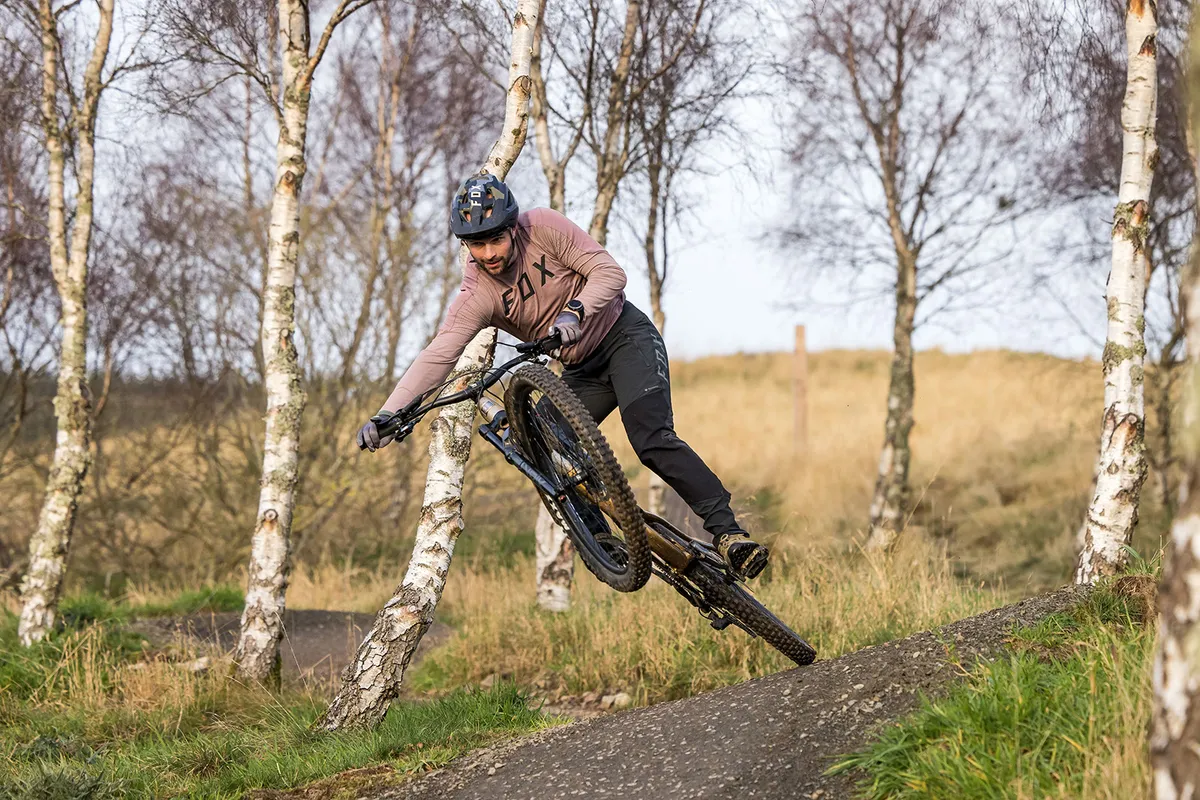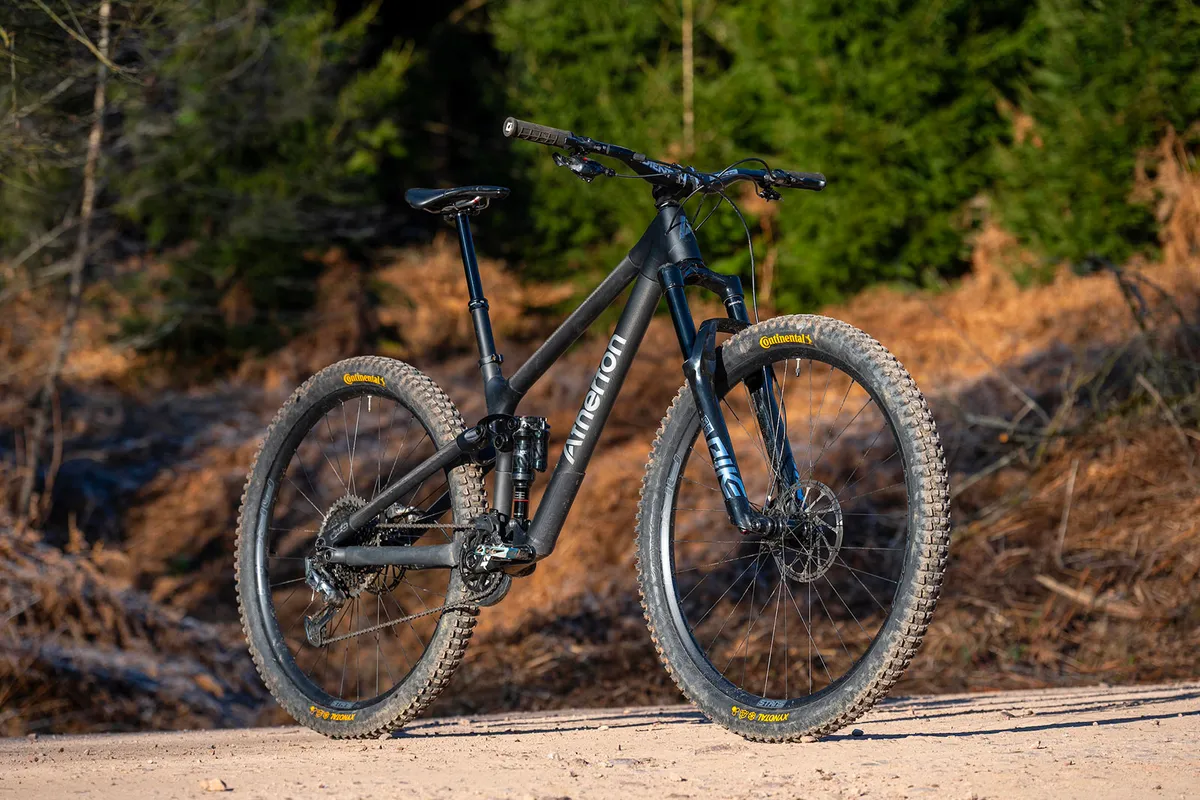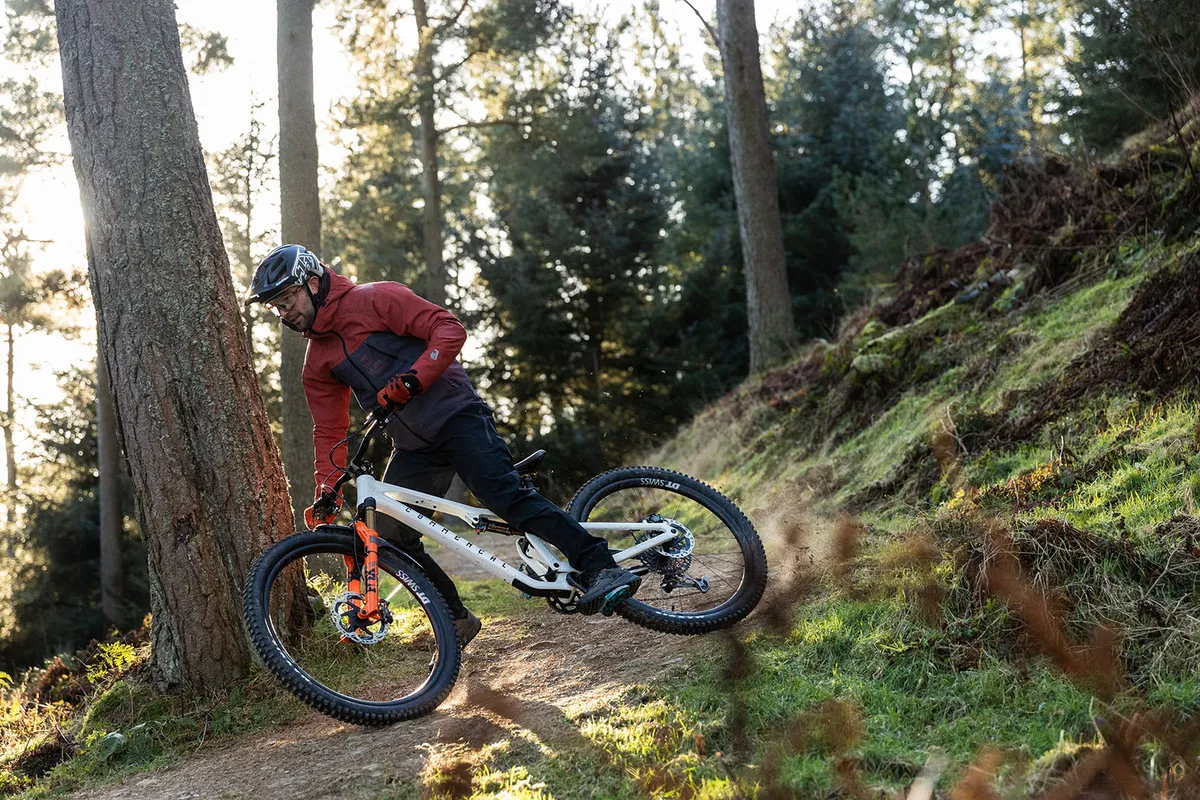Santa Cruz’s all-new Bronson sports mixed wheels (29in front, 27.5in rear) across its five-size range, boasts a 160mm fork with 150mm of Virtual Pivot Point rear suspension travel, and descent-focussed geometry.
Spanning from true trail bike up to almost enduro thrasher, it’s firmly in the cross-over category.
With prices starting at £4,899 / $4,999 / €5,499 and going up to £8,799 / $8,999 / €9,999 for the five-model range, each frame in the new Bronson line-up is made from carbon fibre.
Headlining the updates are tweaks to its geometry; it’s slacker, longer and lower, modified suspension kinematics; it’s less progressive and has lower anti-squat, and a slight variation on frame design.

These light-touch updates means the new Bronson joins a growing number of bikes where incremental rather than revolutionary changes are enough to justify it being called an all-new model.
But why do I think bike development is stalling across the board? It’s unlikely engineers and designers have run out of good ideas.
After years of experience testing the latest, greatest, and worst bikes the industry can create, I think that as performance has lifted up to its current pinnacle, design and development has slowed down.
In my eyes, the industry has got to a point where most bikes ride so well that deviating from the tried and test formula is futile rather than fruitful.
But before I get into it, let’s take a quick look at the new Bronson.
Santa Cruz Bronson 5: Evolution rather than revolution

As a true iterative update, Santa Cruz states it has used learnings from the previous Bronson 4 to make the Bronson 5 a better bike.
First up, its frame has been tweaked. The same dual triangle and low-slung shock tunnel design is correct and present, but gone is the small non-drive sag window replaced by a more open ‘Birds Nest’ triangulated strut.
This, according to the brand, maintains the frame’s robust feel while providing a much better view of shock sag.

Also tweaked is the rear shock’s placement; it now sits deeper into a recess in the downtube rather than standing proud of the tube’s surface.
Once again, this minor tweak means Santa Cruz has fine-tuned anti-squat and progression, which are both down on the previous iteration.
This is claimed to boost the 150mm of VPP travel’s smoothness by helping it absorb more bumps regardless of whether you’re climbing or descending.

The downtube storage door has also been updated – rather than reimagined – with a new latch design. While relatively unimportant in the grand scheme of things, the change increases the perceived quality of the bike.
Finally, and maybe most importantly, its geometry has been updated.

Except for the removal of the small size and addition of an extra-extra-large (previously the range went from small to XL), headlining the changes are longer chainstay figures.
Across the size range these now span from 438mm (small) to 449mm (XXL), which are up 6mm compared to the previous bike’s numbers.
The head angle has been slackened by 0.6 of a degree and the seat tube angle steepened by 1.4 degrees.
Is bike design stagnating or being tuned to perfection?

The changes to Santa Cruz's latest Bronson are hardly morphing bike design into the next dimension, but is that level of dramatic change something we – as bike riders and enthusiasts – need?
I’d argue it's not.
What we do need is for performance to be homed in, refined, and perfected rather than redefined altogether.
Thankfully I can’t remember the last time I rode a bike that made my eyeballs rattle, my muscles tense up in fear, and my voice box to emit unconscious shrieks of displeasure.
Truly awful bikes just don’t exist.

That’s because brands are universally converging on sweet spot geometry figures and suspension kinematics; they know these ingredients work when mixed together to form a bike.
It seems the experimental phase of bike design is well and truly over.
While some may shed a tear the crazy designs of old are out, I’m more than happy for things to trickle along.

I’ve never had so much fun, been able to ride so fast, for so long with such predictably performing bikes than ever before.
This Bronson is just one example of meandering but meaningful changes, and there are many more.
While Specialized’s latest Stumpjumper 15 has plenty of tech in its new Fox GENIE shock, the frame's shape and its geometry hasn’t changed significantly from the previous generation (of Stumpjumper Evo) to this one.

It’s the same with Trek’s Top Fuel, Orbea’s Rise and the YT Capra. Each bike has undergone light touch iterative changes rather than all out redesigns.
Just like the Bronson, that’s for very good reasons; the previous models all performed exceptionally and only needed minimal changes to enhance rather than totally mix up how they ride.

If development is stagnating, what’s next for the industry? Brands like Pole – that produced bikes like the Voima which had an entirely different take on geometry – seem to come and go, with only a fraction of their ideas truly going mainstream.
Yes, suspension designs have evolved from the humble single pivot to the complex six-bar DW6 design found on Atherton Bikes.
But how much more can they change? Limited by physical space and weight – dictated by our human morphology – and complexity leading to failure are massive factors.
Beyond creating bikes that hover above the terrain, what more can suspension designs do in the future, that they can't now?

Talking of Atherton Bikes, they’re also leading the way with 3D printing manufacturing processes that make geometry customisation and frame design changes much easier than traditional welded tube or carbon mould methods.
But Atherton Bikes still look like bikes, and the brand isn't doing anything hugely revolutionary for its model's stock geometry; clearly it's a sign that things are as good now as they'll ever be.

Bike design is stagnating; I think the likelihood of changes big enough to redefine our two wheeled companions as we know them are almost zero.
But the iterative, refinement focussed updates – which may deter people from upgrading when each new model is released – are perfect for boosting performance via marginal gains.
The new Bronson (among others) seem to be the ideal examples of that, and long may it continue.
2025 Santa Cruz Bronson 5 models and pricing
Santa Cruz’s extensive Bronson 5 range starts at £4,899 / $4,999 / €5,499 for the base-spec Bronson C R and lifts to £8,799 / $8,999 / €9,999 for the top-end Bronson CC X0 AXS RSV.
2025 Santa Cruz Bronson C R

- Frame: Carbon C, 150mm travel
- Fork and shock: RockShox Lyrik Base 160mm, Fox Float X Rhythm
- Wheels and tyres: Reserve 30 TR on SRAM hubs. Maxxis Assegai 3C MaxxGrip EXO+ 29x2.5in (f), Maxxis Minion DHRII 3C MaxxTerra EXO+ 27.5x2.4in (r)
- Drivetrain: SRAM NX Eagle
- Brakes: SRAM DB8 Stealth
- Price: £4,899 / $4,999 / €5,499
2025 Santa Cruz Bronson C S

- Frame: Carbon C, 150mm travel
- Fork and shock: Fox 36 Performance 160mm, Fox Float X Performance
- Wheels and tyres: Reserve 30 TR on DT 370 hubs. Maxxis Assegai 3C MaxxGrip EXO+ 29x2.5in (f), Maxxis Minion DHRII 3C MaxxTerra EXO+ 27.5x2.4in (r)
- Drivetrain: SRAM GX Eagle
- Brakes: SRAM DB8 Stealth
- Price: £5,699 / $5,899 / €6,399
2025 Santa Cruz Bronson C GX AXS

- Frame: Carbon C, 150mm travel
- Fork and shock: Fox 36 Performance Elite 160mm, Fox Float X Performance Elite
- Wheels and tyres: Reserve 30 TR on DT 370 hubs. Maxxis Assegai 3C MaxxGrip EXO+ 29x2.5in (f), Maxxis Minion DHRII 3C MaxxTerra EXO+ 27.5x2.4in (r)
- Drivetrain: SRAM GX AXS Transmission
- Brakes: SRAM Maven Bronze
- Price: £6,599 / $6,999 / €7,399
2025 Santa Cruz Bronson CC X0 AXS

- Frame: Carbon CC, 150mm travel
- Fork and shock: Fox 36 Factory 160mm, Fox Float X Factory
- Wheels and tyres: Reserve 30 SL on Industry Nine 1/1 hubs. Maxxis Assegai 3C MaxxGrip EXO+ 29x2.5in (f), Maxxis Minion DHRII 3C MaxxTerra EXO+ 27.5x2.4in (r)
- Drivetrain: SRAM X0 AXS Transmission
- Brakes: SRAM Maven Silver
- Price: £7,799 / $7,999 / €8,799
2025 Santa Cruz Bronson CC X0 AXS RSV

- Frame: Carbon CC, 150mm travel
- Fork and shock: Fox 36 Factory 160mm, Fox Float X Factory
- Wheels and tyres: Reserve 30 HD on Industry Nine 1/1 hubs. Maxxis Assegai 3C MaxxGrip EXO+ 29x2.5in (f), Maxxis Minion DHRII 3C MaxxTerra EXO+ 27.5x2.4in (r)
- Drivetrain: SRAM X0 AXS Transmission
- Brakes: SRAM Maven Silver
- Price: £7,799 / $8,999 / €9,999
2025 Santa Cruz Bronson 5 geometry
| | Small | Medium | Large | Extra-large | Extra-extra-large |
|---|---|---|---|---|---|
| Reach high/low (mm) | 435/432 | 460/457 | 480/478 | 500/498 | 525/523 |
| Stack high/low (mm) | 623/625 | 632/634 | 641/643 | 659/661 | 668/670 |
| Head tube angle high/low (degrees) | 64.2/63.9 | 64.2/63.9 | 64.2/63.9 | 64.2/63.9 | 64.2/63.9 |
| Seat tube angle high/low (degrees) | 77.6/77.3 | 77.9/77.6 | 78.2/77.9 | 78.3/78 | 78.4/78.1 |
| Chainstay high/low (mm) | 437/438 | 439/440 | 442/443 | 445/446 | 448/449 |
| Bottom bracket height high/low (mm) | 344/341 | 344/341 | 344/341 | 344/341 | 344/341 |
| Wheelbase high/low (mm) | 1209 | 1240 | 1267/1268 | 1299 | 1331/1332 |
